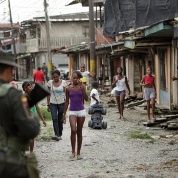Millions of Colombians have fled the country in the past 50 years, trying to escape the civil war that erupted between government forces, paramilitary troops and guerrilla fighters and taken over large territories – what has for years been denounced by human rights organizations.

Over the last 10 years, Venezuela has absorbed at least 30 percent of this Colombian migration, Venezuelan Vicepresident of the Ministry of Planning, Ricardo Menendez confirmed.
According to the ministry, some 5.6 million Colombians are currently living in Venezuela, benefiting from the same rights as Venezuelans, including education, housing and health care. Of those, some 176,000 have official refugee status in the country.
Despite these figures, Colombian President Juan Manuel Santos, and other Colombian officials, have repeatedly accused Venezuela of being anti-Colombian and violating the human rights of Colombians around its border region. In the past month, after paramilitary violence in the area, Venezuela closed its border with Colombia and deported over 1,000 undocumented Colombians.
RELATED: The Height of Hypocrisy: Santos Lectures Others on Human Rights
The incident has caused a diplomatic row between the two countries with President Santos telling Venezuela not to “blame” its problems on Colombia. However, there is renewed attention to the millions of Colombians who remain in Venezuela, and the major issues in their home country that led to what some Venezuelan officials have called a “mass exodus.”
Most of the migration has been caused by the ongoing violence in Colombia. Since the 1950’s, the South American country has been engrained in a civil war which has so far seen over 220,000 people in the country killed while over 6 million people have been displaced – either forced to become refugees in their own country or fled to seek asylum in neighboring countries such as Venezuela and Ecuador.
According to the Internal Displacement Monitoring Center, some 300,000 people are thought to be displaced every year since 2000.
These numbers increased dramatically in the early 2000's when Colombian officials carried out operations known as “false positives,” in which soldiers would kill civilians and dress the corpses up in camouflaged fatigues to pass them off as guerrillas killed in combat. The operations began when then President Alvaro Uribe implemented an incentives program for soldiers, offering them US$1,900 for killing guerrillas.
RELATED: Who Is Alvaro Uribe?
Over 3,000 civilians were killed by soldiers as a result of “false positive” operations, according the International Federation for Human Rights.
Despite the violence that still lingers in the country, many Colombians are also fleeing due to a floundering economy and lack of opportunity in the country.
The recent fall in oil prices that has dramatically impacted the economies of oil producing countries as well as those that rely on export, including Colombia. A survey conducted by the local oil industry association ACP and Burson Marsteller, showed that 37 out of 52 of Colombia's oil companies planned to cut investments, including laying off employees, because of financial costs.
Earlier this year, oil workers' unions went on strike to protest the mass firings of their workers. Over 10,000 workers in Colombia's hydrocarbons sector have lost their jobs this year alone, while that number is said to reach 25,000 by the end of the year, according to the Colombian Ministry of Labor.
Thousands of farmers, Indigenous communities as well as Afro-Colombians have been protesting across the country as well, and organizing national strikes against the government's aggressive policies towards rural communities.
Among those include policies that favor large national and international agribusiness, and singing international free-trade deals that hurt farming communities.
It also includes a law currently being debated by Colombia’s government to allow state-owned land that is officially vacant to be handed over to major national and international business interests for development, despite the country being home to millions of landless and displaced rural poor.
Despite the government's focus on international trade deals and dealings with big business, wealth has not trickled down to the Colombian people.
According to the National Administrative Department of Statistics (DANE), 28.5 percent of the population were living under the poverty line as of November 2014. At least 8.1 percent of those were living in “extreme poverty” conditions, meaning they have no means to purchase basic goods.
The youth of the country have also been effected with recent government figures showing that 56 percent of children across the country live in poverty. The same figures showed that 35.5 percent of children are born weighing under three kilograms – less than half the weight recommended by the World Health Organization.
Colombia's western Choco region is one of the poorest in the country, where 60 percent of its citizens live in poverty.
Mass inequalities in Colombia show little signs of abating under the pro-business policies of President Juan Manuel Santos.